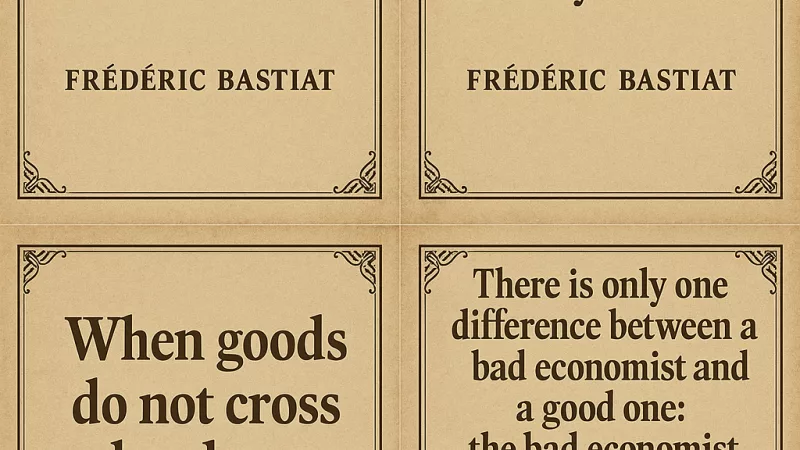Day 31/100 Bastiat

Bastiat
Stormin’
- https://www.lewrockwell.com/2025/11/andrew-wallace/enumerated-powers-forbids-and-workers-object-to-paying-taxes-to-fund-communist-cities/
- https://www.lewrockwell.com/2025/11/paul-craig-roberts/is-trump-killing-his-movement-and-was-epstein-running-a-mossad-blackmail-operation/
- https://www.youtube.com/watch?v=Hik6OY-nk4c
- https://www.youtube.com/watch?v=uXAhiRAn2DY
- precision of vision
- your internal operating system
- circle of influence
- invest in your evolution
- compound effect
- goals that terrify
- design your ecosystem
- elevate your standards
- build powerful rituals
- create accountability
- master rapid recovery
- laser focus
- celebrate incremental wins
- become a value creator
- compete with yesterday’s self
- decide swiftly
- practice daily gratitude
=====
Overview & Market Performance
The Bastiat Collection (LvMI) is a 1,000+ page anthology bringing together most of Frédéric Bastiat’s major economic and political essays in English, edited and published by the Ludwig von Mises Institute around 2007. It is marketed explicitly as “the Bastiat collection the world has needed,” positioning itself as the definitive one-stop volume for Bastiat in English. (Mises Institute)
Across platforms, it performs strongly with readers who already lean toward free-market / classical liberal ideas:
- Goodreads: ~4.58/5 from ~290 ratings (for the 2-volume set). (Goodreads)
- Amazon Kindle (LvMI): ~4.7/5 from ~130+ ratings. (Amazon Read)
- Barnes & Noble: lower but still positive (~3.3/5), suggesting a more mixed response from a broader, less pre-selected audience. (Barnes & Noble)
Demographically and psychographically, buyers skew toward:
- Libertarians, Austrian-school and free-market enthusiasts
- Self-educating adults (often men, 25–60) interested in political economy
- Homeschooling / alternative-education circles looking for primary texts in economics and freedom
- Policy wonks and activists looking for ideological ammunition against tariffs, protectionism, and state intervention
Overall, the book functions as a canon-building, movement text: it reinforces existing beliefs, educates sympathetic newcomers, and gives Bastiat a durable, physical “home” in English.
The Strengths
1. Comprehensive, “all-in-one” Bastiat
- Brings together a wide range of Bastiat’s essays (e.g., The Law, Economic Sophisms, What Is Seen and What Is Not Seen, and more) in one place, which readers consistently describe as convenient and cost-effective compared with buying multiple individual titles. (Mises Institute)
- The size and scope signal authority. For the target audience, owning The Bastiat Collection feels like owning “the complete Bastiat toolbox.”
2. Clarity and accessibility of Bastiat’s style
- Reviewers repeatedly praise Bastiat’s lucid, witty, plain-language exposition of complex economic issues (seen vs. unseen, opportunity cost, legal plunder).
- His use of parables, dialogues, and satire (e.g., the candlemakers’ petition) makes abstract ideas memorable, and this collection gives readers many such pieces in sequence, enhancing impact. (Goodreads)
3. Ideological alignment and identity
- For libertarian and Austrian readers, the book is described as a touchstone or even a “red pill” that clarifies why tariffs, subsidies, and regulation distort the economy. (Facebook)
- It offers moral as well as economic arguments—“legal plunder,” justice vs. privilege—giving readers a moral vocabulary to justify their politics.
4. Editorial positioning and brand
- Being published and promoted by the Mises Institute and edited by Mark Thornton gives it substantial credibility in that ecosystem. (Mises Institute)
- The introduction and packaging position Bastiat as an essential classical liberal thinker, which elevates the perceived importance of reading the book.
5. Physical quality (print set)
- Long-time users of the print edition praise the durability of the two-volume set—binding, paper, and overall production quality hold up even with heavy reading, which matters for a 1000+ page reference work. (store.mises.org)
The Weaknesses
1. Intimidating length and density
- 1000+ pages is a major barrier. Many reviewers mention starting but not finishing, or only reading selected essays.
- The anthology format does not provide a guided progression for modern readers; it can feel like being dropped into the 19th century without a map.
2. Limited modern context
- Bastiat’s examples are mid-19th-century France. Without interpretive commentary, some readers find it hard to connect his discussions of specific tariffs, guilds, or political figures to 21st-century economic policy.
- There is relatively little apparatus—no detailed study guide, minimal “here’s how this applies to modern debates about minimum wage, stimulus, healthcare, climate policy, or digital trade.”
3. Preaching to the choir
- The positioning and publisher branding mean the book largely circulates inside ideological echo chambers (libertarian, Austrian, Mises-adjacent circles).
- For less ideologically aligned readers, the tone of some essays can feel polemical or one-sided, lacking engagement with serious counterarguments. That limits reach into mainstream academic or centrist policy audiences.
4. Usability and navigation
- Readers occasionally complain about small print, dense layout, and minimal visual breaks in some editions.
- The internal organization is more archival than pedagogical: essays are compiled, but not restructured for readers who want step-by-step learning (e.g., “Start here if you’re new,” “Read these next if you’re a policy analyst,” etc.).
5. Uneven relevance across essays
- Not every essay lands equally well. Some are highly technical, context-bound, or repetitive, so the reading experience can feel uneven.
- Without guidance, readers don’t always know which essays are “must-read” vs. “specialist interest,” which can create fatigue and drop-off.
Why Readers Bought the Book (What They Liked)
Based on historical review patterns and cross-platform sentiment, buyers are primarily motivated by:
- Desire for a definitive Bastiat resource
- “All the major Bastiat in one place” is a key selling point for enthusiasts and students.
- It’s often purchased as a core library item: something you “should own” if you care about liberty, economics, or political philosophy.
- Recommendations from trusted communities
- Many buyers discovered it via Mises Institute lists, libertarian reading lists, podcasts, YouTube channels, and homeschooling forums, where it’s recommended as essential reading. (Facebook)
- Clarity and rhetorical power
- Readers praise how Bastiat “makes economics crystal clear” and “blows up protectionist myths” in a way that feels both intellectually satisfying and emotionally energizing.
- Quotes from the collection circulate widely on social media and in quote sites, which drives curiosity and purchase. (Goodreads)
- Affordability vs. buying multiple separate works
- Compared with purchasing separate Bastiat titles, the collection offers a high value-per-dollar proposition, especially in paperback or Kindle form. (Amazon)
- Historical importance and “intellectual heritage”
- Buyers see themselves as tapping into a tradition: Bastiat → Mises → Hayek → modern libertarians. Owning and reading the collection feels like joining that intellectual lineage. (Pepperdine Digital Commons)
Why Some Did Not Buy or Did Not Finish (What They Disliked)
- Sheer size and perceived difficulty
- Potential readers are put off by the page count and thickness; it looks like a serious time commitment.
- Some would rather buy a slim, focused volume (e.g., The Law) instead of a massive anthology.
- Ideological suspicion
- Readers outside the free-market sphere can see the branding (Mises Institute, Austrian economics, libertarian blurbs) and conclude it’s too partisan or propagandistic, not a neutral introduction to economics.
- Lack of handholding for modern readers
- No clear reading plan, little contextual commentary, and limited pedagogical scaffolding make it harder for beginners or casual readers to stay engaged.
- Academically oriented readers sometimes prefer editions with heavy scholarly apparatus—footnotes, introductions, historical context, engagement with critics—which this collection largely lacks.
- Physical / formatting complaints
- Some editions are criticized for small print, dense text, or minimal margin space, making long sessions physically tiring to read. (store.mises.org)
- Overlap with free digital content
- Bastiat’s works are public domain and widely available online. For cost-conscious readers, the question becomes: Why pay for a print/Kindle collection when I can download a PDF?
- The collection must therefore justify itself not only on content but also on curation, usability, and durability—and doesn’t always persuade more utilitarian readers.
- Bastiat’s works are public domain and widely available online. For cost-conscious readers, the question becomes: Why pay for a print/Kindle collection when I can download a PDF?
Strategic Takeaways for a Competing Self-Published Book
If you’re a self-published author entering this market—say, with a “Bastiat for today” or “Economic literacy in plain English” book—here are 7–10 critical elements to include, plus key mistakes to avoid:
- Sharp, modern positioning and title/subtitle
- Element: Frame the book around a clear 21st-century problem:
- e.g., “What Is Seen and Unseen in Today’s Economy: How to Think Like Bastiat About Debt, Taxes, and the Welfare State.”
- e.g., “What Is Seen and Unseen in Today’s Economy: How to Think Like Bastiat About Debt, Taxes, and the Welfare State.”
- Avoid: Vague “Collected Essays on Liberty” titles that get lost among classics and reprints.
- Element: Frame the book around a clear 21st-century problem:
- Explicitly defined audience and reading path
- Element: State upfront who the book is for (e.g., “concerned citizens with no econ background,” “homeschool parents,” “policy staffers”), and provide reading roadmaps and “choose your path” sections.
- Avoid: Writing as though your reader is already an Austrian-school insider.
- Modern case studies that parallel Bastiat’s classic insights
- Element: Take Bastiat’s core ideas (seen vs. unseen, legal plunder, broken window fallacy) and apply them concretely to:
- stimulus bills, minimum wage, rent control, trade wars, student loans, healthcare mandates, ESG regulations, etc.
- Avoid: Staying stuck in 19th-century examples or simply rephrasing Bastiat without adding value.
- Element: Take Bastiat’s core ideas (seen vs. unseen, legal plunder, broken window fallacy) and apply them concretely to:
- Teaching architecture: summaries, visuals, and exercises
- Element: Add chapter summaries, key bullet points, diagrams, tables, and short exercises (“spot the unseen effects,” “rewrite this news headline in Bastiat’s terms”).
- Avoid: Wall-of-text chapters with no visual or structural relief.
- Balanced engagement with critics
- Element: Briefly and fairly present mainstream and progressive critiques of Bastiat (market failures, externalities, inequality) and respond to them. This widens appeal and credibility.
- Avoid: Pure echo-chamber tone that assumes dissenters are stupid or evil.
- Narrative and human stories
- Element: Weave in short narratives—modern workers, small business owners, consumers—showing how policy decisions affect real people, echoing Bastiat’s moral focus but in today’s world.
- Avoid: Purely abstract, bloodless argumentation that never shows lived experience.
- Clear, senior-friendly and student-friendly design
- Element: Use larger, readable fonts; generous spacing; headings; short sections; ample white space (huge for older readers and long study sessions).
- Avoid: Tiny print, narrow margins, and dense paragraphs just to save pages.
- Companion resources and ecosystem
- Element: Offer downloadable PDFs, cheat sheets, discussion questions, and a short “Bastiat in 90 minutes” quick-start guide; maybe audio summaries or a mini-course.
- Avoid: Treating the book as a standalone artifact, disconnected from any ongoing learning journey or community.
- Strategic differentiation from The Bastiat Collection
- Element: Make your marketing copy explicitly position your book as:
- more practical (“how to think like Bastiat in today’s debates”),
- more guided (coaching the reader), and
- more approachable (shorter, better structured).
- Avoid: Competing head-on as a “complete Bastiat” anthology; you will lose against the established LvMI edition and free online texts.
- Element: Make your marketing copy explicitly position your book as:
- Professional editing and production values
- Element: Invest in tight editing, clean typography, and an index/glossary. In this niche, sloppy production screams “amateur ideology” and kills trust.
- Avoid: Typos, inconsistent terminology, missing references, or clunky layout—especially when your target readers are used to polished classics.
If you build a book that translates Bastiat for today—rather than merely repackaging him—you can live alongside The Bastiat Collection instead of being crushed by it, and you’ll give readers something it does not currently provide: a guided, contemporary, and deeply usable way to think economically.
=====
You’re stuck because you have nothing to offer.
- No lead magnets to build a list
- No products to sell
- No content to post
- No emails to send
- Nothing to give away in Facebook groups
- Nothing to turn into YouTube videos
- No value to bring to the table…
=====
Whey is the liquid byproduct of the cheesemaking process, separated from the milk curds. It is a complete protein source, meaning it contains all nine essential amino acids, and is rich in branched-chain amino acids (BCAAs), which are important for muscle growth and repair. The liquid whey is often processed into a powdered supplement, but it is also used in various food products. [1, 2, 3, 4]
What it is
- A dairy protein: Whey is one of the two main proteins in milk, the other being casein. [2, 3]
- Byproduct of cheesemaking: It’s the watery liquid that is drained from the solid curds when milk is coagulated to make cheese. [1, 3, 5]
- Nutrient-rich: It contains protein, vitamins, minerals, and carbohydrates. [6, 7]
How it’s processed
- The liquid whey is filtered to remove fats and other non-protein components. [1]
- It is then dried into a powder, which is commonly sold as a nutritional supplement. [1, 8]
- There are different types of whey protein powder, including concentrate, isolate, and hydrolysate, which have varying levels of processing and protein content. [5, 6]
Uses and benefits
- Dietary supplement: Whey protein powder is often added to smoothies, protein bars, and other foods to increase protein intake. [2, 8]
- Muscle growth: It is rapidly absorbed and contains leucine, an amino acid that can help rebuild muscle, especially when combined with resistance exercise. [1, 4]
- Weight management: Some studies suggest that increasing protein intake with whey can help with weight management goals and improve other metabolic measures. [4]
AI responses may include mistakes.
[1] https://unjury.com/blogs/resource-library/what-is-whey-protein-and-how-is-it-made
[2] https://thedairyalliance.com/blog/what-are-whey-products-and-how-can-they-be-used-in-meals
[3] https://www.masterclass.com/articles/what-is-whey
[4] https://www.usdairy.com/news-articles/what-is-whey-whey-protein-101
[5] https://www.mysportscience.com/post/what-is-whey-protein
[6] https://www.drugs.com/medical-answers/question–whey-3573607/
[7] https://www.britannica.com/topic/whey
[8] https://www.eatingwell.com/article/7940039/what-is-whey-protein-according-to-a-dietitian/
=====





